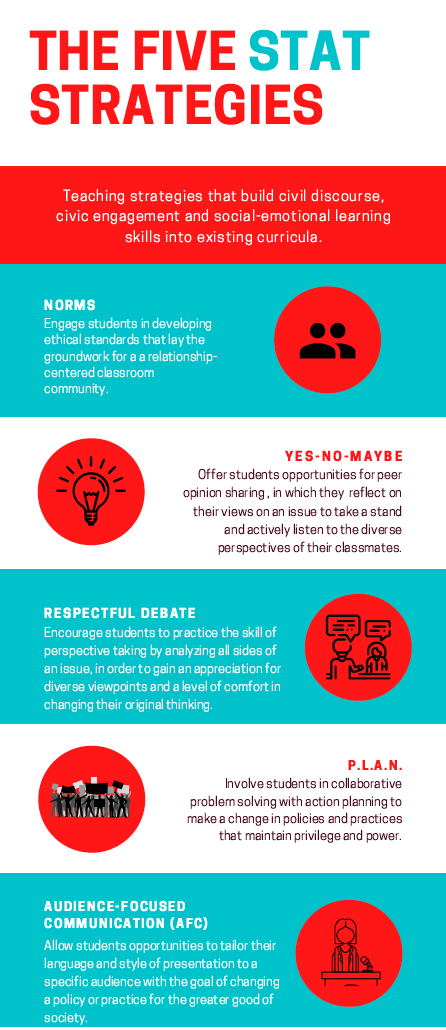We suggest that you teach the strategies in the order presented below, as they have been designed in such a way to build on one another in a spiraling fashion. For example, by teaching the Yes-No-Maybe strategy prior to Respectful Debate, your students will be competent in the areas of peer opinion sharing and taking a stand on an issue, both of which are skills necessary for their success with Respectful Debate. However, the progression is not linear by any means - we expect and encourage teachers to revisit previously introduced strategies with their students to continue to provide them with opportunities to practice the skills.
Norms
Unlike classroom rules, which are generally established by the teacher to create an efficient and safe environment, norms are co-created by students to make for a relationship-centered learning community in which students can openly communicate with one another. Through a discussion facilitated by the teacher, students decide upon desirable and undesirable classroom behaviors. Ultimately, they develop a list of affirmatively stated norms and discuss the rationale behind each norm and its impact on the students’ well-being. Students also collectively determine ways to handle “norm-breaking”. Norms lay the foundation to successfully implement STAT lessons, by cultivating a climate that will promote respectful listening, peer opinion sharing, empathic debate, and collaborative problem-solving.
Yes-No-Maybe
Building off the work accomplished in developing norms, where a climate fostering trust, participation, and equitable expectations are established, Yes-No-Maybe is a strategy that facilitates peer opinion sharing. It is a deceptively simple entry-level strategy that is easy to implement and supports students in building the skills of perspective-taking and respectful listening. Students reflect on several neutral statements related to a historic or current event and take a stance on each. They then practice respectful listening by discussing their opinions in small groups. Students are given the opportunity to change their stance on an issue after hearing the diverse viewpoints of their peers. The instructor facilitates these conversations but does not seek to arrive at a consensus or other conclusion.
Respectful Debate
With the skills of perspective-taking and respectful listening in place, Respectful Debate introduces students to the more complex skill of establishing and defending an informed position on a topic while empathically listening to opposing views. Respectful debates provide ample opportunities for students to practice their emotional regulation skills. Students are assigned the stance of “pro” or “con” and must work in small groups. Given background sources, students collect evidence for their assigned stance on the issue. However, unlike traditional classroom debates, students are charged with arguing from both sides of an issue and intentionally reflecting on the position of their opposition, allowing them to more objectively analyze the issue and broaden their perspectives. This poses a major challenge when students strongly disagree with one side of the issue and they find themselves dealing with strong emotions that they must regulate. However, this presents instructional openings for teachers to teach emotional regulation techniques, such as deep breathing and positive self-talk.
Audience-Focused Communication
The next strategy that we will examine is Audience-Focused Communication. This is a stand-alone strategy (AFC Generic) that can be used for students to present on small-scale classroom and school issues, such as making the transition from middle school to high school or responding to peer pressure. However, it can also be used as a natural extension of PLAN (PLAN Integrative), in that it provides students with detailed guidance with regard to how to best present the solutions and action plans that they developed. The essence of AFC is that students identify their audience, determine the format of their presentation (e.g., model, photo essay, video, song, commercial) and take into consideration their audience’s views and prior knowledge to most effectively convey the information. This requires that students tap into skills from all five CASEL competencies, which also are developed in practicing the four other STAT strategies.
PLAN
The fifth and final strategy, PLAN, builds on the skills students practice in the preceding strategies and shifts the focus to social problem solving and action planning to prepare students to take civic action. PLAN stands for Problem definition, Listing options, Action plan, and Notice success and lessons for next time. To elaborate a bit, students work in small groups to collaboratively examine and evaluate a historic or current problem that has no obvious solution or perhaps revisit a past situation to better understand how different analyses or decisions might have led to different actions and outcomes. Then, they consider the options to address the problem and weigh the pros and cons of each. Students work together to develop a SMART goal and related action plan to solve the problem. They also engage in perspective-taking to consider the impact of their action plan on the various stakeholders involved and look to implement when feasible (hence, the title, Students Taking Action Together). The process culminates with a reflection, in which students notice successes with their plan and possible revisions to their thinking to be more successful the next time around.
Are you ready to integrate STAT into your lesson plans?
Integrating social-emotional learning principles into your classroom can reap huge rewards. Whether you’re ready to start today or just learning, we have the tools to help you easily sync SEL with your existing lesson plans. Sign up today for exclusive access to our webinars, bulletin releases, and lesson plans.
Check Out Our STAT Bulletins!
Additional Information
If you are interested in learning more about STAT, check out our STAT resources for online tools, articles, webinars and more!



